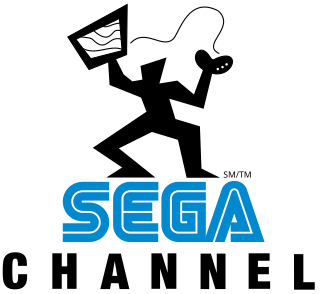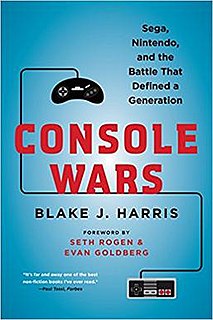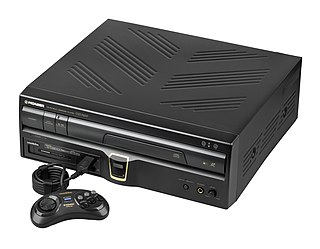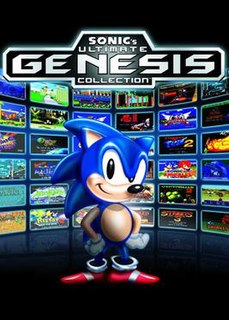 W
WThe Sega Genesis, known as the Mega Drive outside North America, is a 16-bit fourth-generation home video game console developed and sold by Sega. The Genesis is Sega's third console and the successor to the Master System. Sega released it as the Mega Drive in Japan in 1988, and later as the Genesis in North America in 1989. In 1990, it was distributed as the Mega Drive by Virgin Mastertronic in Europe, Ozisoft in Australasia, and Tec Toy in Brazil. In South Korea, it was distributed by Samsung as the Super Gam*Boy and later the Super Aladdin Boy.
 W
WThe 32X is an add-on for the Sega Genesis video game console. Codenamed "Project Mars", the 32X was designed to expand the power of the Genesis and serve as a transitional console into the 32-bit era until the release of the Sega Saturn. Independent of the Genesis, the 32X uses its own ROM cartridges and has its own library of games. It was distributed under the name Super 32X in Japan, Genesis 32X in North America, Mega Drive 32X in the PAL region, and Mega 32X in Brazil.
 W
WThe Sega Channel was an online game service developed by Sega for the Genesis video game console, serving as a content delivery system. Launched in December 1994, the Sega Channel was provided to the public by TCI and Time Warner Cable through cable television services by way of coaxial cable. It was a pay to play service, through which customers could access Genesis video game console games online, play game demos, and get cheat codes. Lasting until July 31, 1998, the Sega Channel operated three years after the release of Sega's next generation console, the Sega Saturn. Though criticized for its poorly timed launch and high subscription fee, the Sega Channel has been praised for its innovations in downloadable content and impact on online game services.
 W
WConsole Wars: Sega, Nintendo, and the Battle That Defined a Generation is a 2014 non-fiction novel written by Blake J. Harris. It follows businessman Tom Kalinske in his venture as CEO of video game company Sega of America, and details the history of the fierce business competition between Sega and Nintendo throughout the 1990s as well as the internal conflicts that took place between Sega of America and Sega of Japan. Harris wrote the book in the style of a novel by compiling several interviews with people who were involved with the events, using the information gathered to create a dramatic interpretation of the events. A film adaptation of the book directed by Seth Rogen and Evan Goldberg was announced in February 2014 and released in September 23, 2020.
 W
WGreen Hill Zone or simply Green Hill is the first level of the platform game Sonic the Hedgehog, which released for the Sega Genesis in 1991. The level is grassy and lush, with environmental features such as palm trees, vertical loops and cliffs, and is the home of numerous forest animals. Like the game's other levels, Green Hill comprises 3 acts; in the third, Sonic fights antagonist Robotnik before moving to the second level, Marble Zone. It was constructed by level designer Hirokazu Yasuhara and its musical theme was created by Masato Nakamura.
 W
WThe J-Cart is a special ROM cartridge developed by Codemasters for the Sega Genesis console. It held not only the game data but also came with two additional gamepad ports. This effectively allowed four players to play simultaneously without any extra adapters. The first J-Cart game, Tennis All-Stars, was released in early 1994.
 W
WAnalogue x Hyperdub: Konsolation is a 2019 compilation album by Hyperdub artists in collaboration with hardware manufacturer Analogue. The album includes previously unreleased music from artists such as Burial, Scratcha DVA, and Ikonika, and was released as a video game cartridge bundled with a limited edition of Analogue's Mega Sg, a remake of the Sega Genesis. Konsolation was created in an edition of 1,000 units as part of Hyperdub's 15th anniversary celebration.
 W
WThe LaserActive is a converged device and fourth-generation home video game console capable of playing Laserdiscs, Compact Discs, console games, and LD-G karaoke discs. It was released by Pioneer Corporation in 1993. In addition to LaserActive games, separately sold add-on modules accept Mega Drive/Genesis and PC Engine/TurboGrafx 16 ROM cartridges and CD-ROMs.
 W
WMega Power was launched following the success of Paragon Publishing's first publication, Sega Pro. Dave Perry along with a small editorial team helped the magazine become the first console publication to include a cover CD. The magazine was in circulation between August 1993 and July 1995.
 W
WThe Sega CD, released as the Mega-CD in most regions outside North America and Brazil, is a CD-ROM accessory for the Mega Drive/Genesis designed and produced by Sega as part of the fourth generation of video game consoles. It was released on December 12, 1991 in Japan, October 15, 1992 in North America, and April 2, 1993 in Europe. The Sega CD plays CD-based games and adds hardware functionality such as a faster central processing unit and graphic enhancements like sprite scaling and rotation. It can also play audio CDs and CD+G discs.
 W
WThe Menacer is a light gun peripheral released by Sega in 1992 for its Sega Genesis and Sega CD video game consoles. It was created in response to Nintendo's Super Scope and as Sega's successor to the Master System Light Phaser. The gun is built from three detachable parts, and communicates with the television via an infrared sensor. The Menacer was announced at the May 1992 Consumer Electronics Show in Chicago and was released later that year. The gun was bundled with a pack-in six-game cartridge of mostly shooting gallery games. Sega also released a Menacer bundle with Terminator 2: The Arcade Game.
 W
WThe Genesis Nomad, also known as Sega Nomad, is a handheld game console manufactured by Sega and released in North America in October 1995. The Nomad is a portable variation of the Sega Genesis home video game console. Based on the Mega Jet, a portable version of the home console designed for use on airline flights in Japan, Nomad was the last handheld console released by Sega. In addition to functioning as a portable device, it was designed to be used with a television set via a video port. Released late in the Genesis era, the Nomad had a short lifespan.
 W
WSega Genesis Collection is a compilation of video games developed by Digital Eclipse and published by Sega for PlayStation 2 and PlayStation Portable. The collection includes twenty-eight Sega Genesis games from a variety of genres, as well as unlockable classic Sega arcade games, with different sets of arcade games for the PlayStation 2 and PlayStation Portable versions. A sequel was released in 2009 called Sonic's Ultimate Genesis Collection for PlayStation 3 and Xbox 360.
 W
WThe Sega Genesis Mini, known as the Mega Drive Mini in regions outside of North America, is a dedicated console modeled on Sega's Genesis. The Mini emulates the original console's 16-bit hardware, and includes 42 games ported by M2. It was released in North America and Japan in September 2019, and in Europe and the Middle East the following month.
 W
WSega Pro was the first publication from Paragon Publishing and catered for the Sega consoles: the Master System, Game Gear and the Mega Drive. Early editorial staff included Dominic Handy (editor), Les Ellis, Dave Perry (designer), Simon Christophers (designer), James Scullion and Damian Butt as staff writers. The magazine existed between 1991 and 1996.
 W
WSonic's Ultimate Genesis Collection is a compilation of video games developed by Backbone Entertainment and published by Sega for PlayStation 3 and Xbox 360. The compilation features 48 Sega games which were previously released for the Sega Genesis, arcades and the Master System. It is the sequel to the Sega Genesis Collection released previously for the PlayStation 2 and PlayStation Portable, but contains 16 more games.
 W
WThe TeraDrive is an IBM PC compatible system with an integrated Mega Drive, developed by Sega and manufactured by IBM in 1991. The TeraDrive allowed for Mega Drive games to be played the same time as the PC section is being used, as it is possible for the Mega Drive and PC hardware to interact with each other.